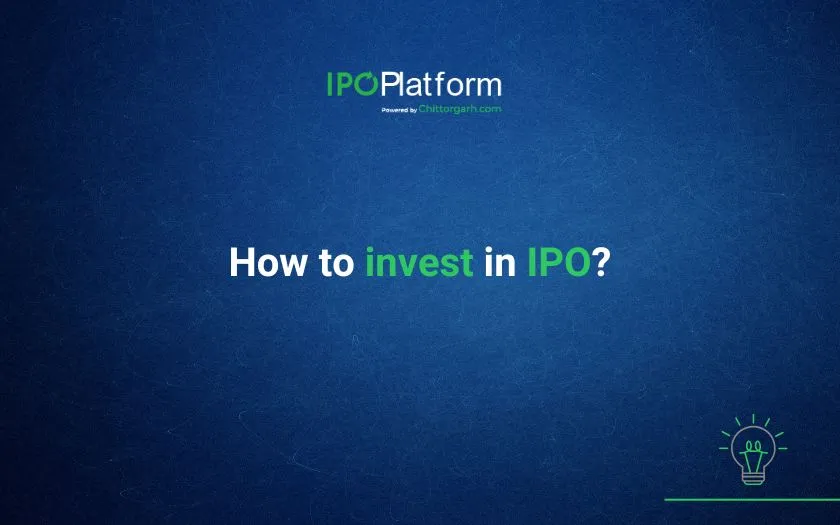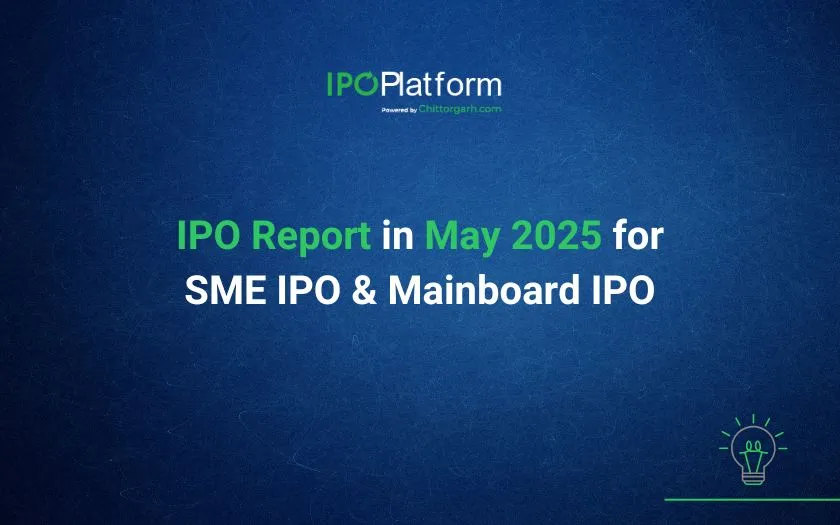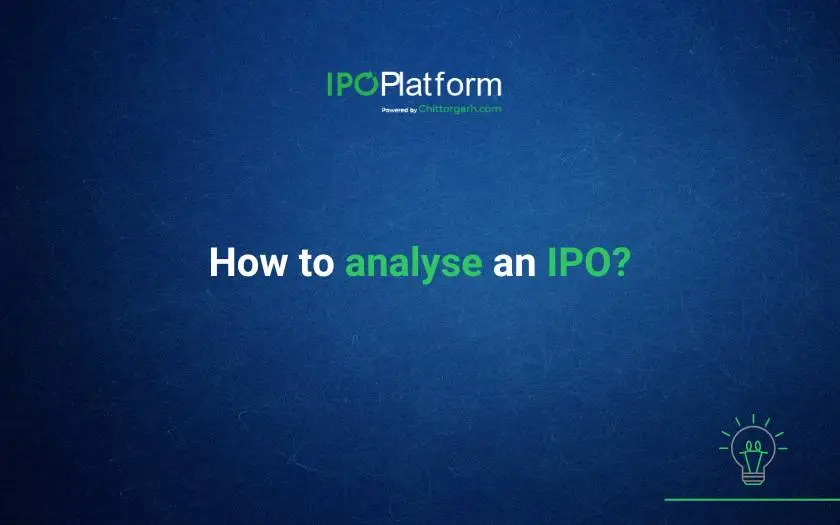How To Invest In IPO?

It is crucial to know and understand the different categories of investors who can invest in an IPO. Various categories like QIBs, NII/HNI, Retail, and anchor investors have their respective quotas in IPO. A category to invest in can be decided based on his/her eligibility and investment amount. Subscription levels can be analysed as per the investor category which can assist in the decision making wrt to IPO or not. Different IPO investor categories have different quotas, lock-in requirements, and rules for making investments.
Who Can Invest in an SME IPO?
An investor can invest in an Initial Public Offer in any of the four categories as laid down in the SEBI ICDR (Regulations). This category is
-
Institutional Investors or QIBs
- Non-Institutional Investors (NII)/High Net Worth Individuals (HNI)
- Retail Individual Investors (RII)
- Eligible Shareholders
- Eligible Employee reservation
- Anchor Investors
What role does IPO Advisors play in successful IPO?
IPO Advisors play an important role in successful launch of an IPO. Their advisory role from IPO readiness, selecting the best merchant banker in India for SME IPO, various due diligence activities and IPO valuation guides the company throughout the IPO Issue and listing process. IPO platform in India provides information on upcoming IPOs on NSE Emerge and BSE SME and list of merchant bankers and anchor investors. Role of IPO advisor is important in the success of the listings.
QIBs (Qualified Institutional Buyers)
This investor category stands for Qualified Institutional Buyers. QIB meaning in IPOs are the investors registered with SEBI. QIBs often are large financial institutions that have the expertise and financial strength to invest in capital markets. The merchant bankers in India sell shares to them as per their quota laid down in SEBI regulations. Commercial banks, mutual fund houses, public financial institutions, and foreign portfolio investors fall under this category. The QIB category includes financial institutions with significant assets under management Not more than 50% of shares can be allocated in this category in either Mainboard or SME IPO.
What are the benefits of QIBs?
Subscriptions from QIB infuse confidence amongst retail investors to invest in IPOs. Also good QIB investor base brings investor expertise and this could benefit the company in the long run.
Who can be QIB (Qualified Institutional Buyers)?
Regulation 2(1) of the SEBI (Issue of Capital and Disclosure Requirements) Regulations, 2018, A Qualified Institutional Buyer (QIB) includes various types of investors that meet specific criteria for investing in securities. These include:
- Mutual funds, venture capital funds, alternative investment funds, and foreign venture capital investors registered with the relevant authorities.
- Foreign portfolio investors, excluding individuals and family offices.
- Public financial institutions.
- Scheduled commercial banks.
- Multilateral and bilateral development financial institutions.
- State industrial development corporations.
- Insurance companies registered with the Insurance Regulatory and Development Authority of India.
- Provident funds with a minimum corpus of ₹25 crore.
- Pension funds with a minimum corpus of ₹25 crore.
- The National Investment Fund was established by the Government of India.
- Insurance funds are managed by the armed forces of India.
- Insurance funds are managed by the Department of Posts, India.
- Systemically important non-banking financial companies.
What are the criteria to become QIB investors?
To become a Qualified Institutional Buyer (QIB) in India, an entity must meet the following criteria:
- Must be registered with the Securities and Exchange Board of India (SEBI).
- Should have substantial financial assets, typically exceeding ₹100 crore.
- Can be a scheduled commercial bank, public financial institution, insurance company, mutual fund, pension fund, or foreign institutional investor.
- May also include state industrial development corporations, multilateral and bilateral development financial institutions, or provident funds with a minimum corpus of ₹25 crore.
- Can be classified as a systemically important non-banking financial company (NBFC).
- Includes insurance funds managed by the Indian Army, Air Force, or Navy.
- Covers insurance funds managed by the Department of Posts, India.
- Includes the National Investment Fund.
What are the other regulatory requirements for the QIB category investors?
In a book-building process, as per Regulation 32 (1) (c) of SEBI (ICDR) Regulations, 2018; the allocation in the net offer shall not exceed fifty percent to qualified institutional buyers, with five percent of that specifically allocated to mutual funds.
Additionally, beyond this five percent allocation, mutual funds shall also be eligible for allocation from the remaining balance if available for qualified institutional buyers.
The issuer may allocate up to sixty percent of the portion available for qualified institutional buyers to anchor investors, in accordance with the conditions specified in Schedule XIII. (Book Building Process). Merchant Bankers, Promoters, and direct relatives are not allowed to invest in the anchor investor category.
Non-Institutional Investors (NIIs)/(HNI)
HNI full form is High Net Worth Individuals. These are investors other than Retail Individual Investors and Qualified Institutional Buyers. These are individual investors who invest more than ₹2 lakhs, but they are not considered institutional investors. NIIs usually include high-net-worth individuals (HNIs) who apply for a larger share of the IPO compared to retail investors. 15% of the offer size is reserved for the HNI quota in an IPO.
What are sHNIs and bHNIs?
SEBI has categorised HNI/NII into two subcategories:
Small High net worth individuals (sHNIs)- High net worth individuals who invest between Rs 2-10 lakhs in an IPO.
bHNIs-High Networth Individuals who invest more than Rs 10 lakhs in an IPO.
One-third of the shares in the NII category are reserved for sNII, and two-thirds are reserved for bNII.
What is the Difference between QIBs and HNIs?
|
Basis |
QIBs |
HNIs |
|
Who can Apply |
Public financial institutions, commercial banks, mutual funds, Foreign Portfolio Investors |
Resident Indian individuals, NRIs, HUFs, companies, trusts, etc., applying for over ₹2 lakh |
|
Reservation |
|
|
|
Apply at the Cut-off price |
Not eligible to bid at cut-off price |
Not eligible to bid at cut-off price |
|
Allotment Basis |
Proportionate allocation |
Allocation on lottery basis |
|
Bid Withdrawal |
Not Applicable |
Not Applicable |
|
Price Modification |
Possible but in upward direction only. |
Possible until the bidding closes. |
|
SEBI Registration |
Required for institutions |
Not Applicable |
|
Lock-in Period |
No lock-in period. |
No lock-in period. |
|
Retail participation |
No such provision. Only eligible institutions can apply |
Retail investors who want to apply for more than 2 Lakhs, can apply under HNI |
|
Anchor participation |
The issuer may allocate up to 60% of the portion available for qualified institutional buyers to anchor investors |
No such provision |
Retail Individual Investors (RIIs):
General public invests in the IPO under this category. This category includes investors who invest less than Rs 2,00,000 in the IPO.
- Resident Indian Individuals
- NRI
- HUF
Investors can bid at the cut off price; minimum 35% of the offer is reserved for retail investors. However, to be noted that in case of companies that do not satisfy the profitability track record of 3 years in case of mainboard IPO, SEBI has mandated to allot only 10% of offer to this category of IPO investors.
If a retail investor wants to apply more than Rs 2,00,000; he can invest in the NII category
Allotment criteria in retail quota
In case of oversubscription- The allotment is done by the registrar based on the lottery method.
In case of a full subscription- The allotment is done to all the applicants in case the subscription is 1x
Eligible shareholders Quota
Who are the Eligible Shareholders?
Eligible shareholders typically include individual and HUF (Hindu Undivided Family) investors who hold shares of the parent company on a specific date set by the IPO. Generally, Individual and HUF shareholders who own shares of the parent company on a specific date also called record date might become eligible shareholders and apply under this category.
Some IPOs set aside a special portion for eligible shareholders of the parent company. The IPO Prospectus Document has all the details about who qualifies, how much they can bid, and how shares will be allocated. The rules may vary on company to company basis.
What are the benefits of shareholder quota in IPO
Shareholder quota category application may increase the chances of allocation. Applicants in the shareholder quota are also eligible to apply in the retail and employee category. Additional discounts may be offered and The bid at the cut-off price is available for applications up to Rs 2 lakh.
What is the Shareholder Quota Limit
A shareholder can invest up to the total shares offered in the shareholder reserved category. Some companies provide a discount on share prices for IPO applications up to Rs 2 lakh.
What is the Lock period for shareholders' quota?
There is no lock-in requirement for the employee reservation category. They can sell the shares anytime after listing like the retail category of investors.
Eligible Employees Quota
Who are the Eligible Employees?
The company may set aside part of the IPO just for its eligible employees. The eligibility rules are detailed in the prospectus.
Generally, the following employees can apply for this reserved category:
- Permanent or full-time employees of the company, its parent company, or subsidiaries, whether in India or abroad.
- Employees who are closely related to full-time or part-time directors.
- Employees who are closely related to entities whose financial statements are combined with the company's.
What is Employee quota/reservation in IPO?
The employee reservation quota for an IPO offering may not exceed 5% of the company's post-issue paid-up capital as per the regulations.
Though there is no specific investment limit for employees. However, to avail of the employee discount (if any), the investment amount should not exceed Rs 2 lakhs.
What are the benefits of employee quotas?
Employee quota is a type of appreciation for the employees. It motivates them to be part of the organisation.
Benefits employees by providing them an opportunity to buy the stock at a lower price during IPO as employee reservation shares generally are offered at a discounted price. It is to be noted that the discount offered should not be more than 10% of the IPO price offered to other categories of investors.
What is the Lock-in period for employee reservation quota?
There is no lock-in requirement for the employee reservation category. They can sell the shares anytime after listing like the retail category of investors.
What happens to ESOPs during IPO?
Many companies give ESOPs to employees as an incentive to retain talent. Unlisted companies align their exercise period with IPO so that employees can exercise options on IPO and benefit from immediate liquidity. Therefore, from employees’ standpoint, an IPO is a huge milestone as their vested ESOPs may be exercisable (in case exercise is linked to the IPO) and shares are encashable at the market price. After the IPO, these shares (ESOPs converted shares) have a lock-in requirement of 1 year.
Companies shall have an employee agreement for ESOPs exercise option. If an employee leaves the company before an IPO, the provision made in the employee agreement for ESOPs shall be followed.
Anchor Investors
Who can become Anchor Investors?
Anchor investors are QIBs registered with SEBI, that are allocated shares at a fixed price before the IPO is opened to the public. Another category of investors cannot be anchor investors.
These investors have to place a bid of at least Rs 10 crore in a mainboard IPO or Rs 1 crore in an SME IPO during the book-building process. Bidding in the anchor category starts a day before the IPO opens and allotment also happens on the same day.
Investment Limit for Anchor Investors
- The minimum bid for anchor investors is Rs 10 crore in mainboard IPOs and Rs 1 crore in SME IPOs.
- Anchor investors can receive up to 60% of the QIB share, with one-third reserved for domestic mutual funds.
What are the rules governing anchor investors
- They can apply for up to the total shares offered in the anchor category.
- Bids once placed cannot be changed or withdrawn.
- Allocation of shares occurs on the same day as the bid submission.
- Anchor investors must pay the full bid amount at the time of application.
- Family members, relatives, merchant bankers, and promoters are restricted from applying as anchor investors.
What is the Anchor Investor Lock-in Period
Shares that are purchased by anchor investors in this investor category are subject to a 50% lock-in period of 30 days and the remaining 50% lock-in requirement is 90 days from the date of allotment.
Share Allocation in SME IPO
The allocation of shares in an SME IPO depends on whether the offering is made through the book-building process or the fixed price method:
a. Allocation Through the Book-Building Process:
- Retail Individual Investors (RIIs):
- At least 35% of the total shares are reserved for retail individual investors, ensuring that regular investors have a fair chance to participate.
- Non-Institutional Investors (NIIs):
- A minimum of 15% of the shares must be allocated to non-institutional investors, typically high-net-worth individuals.
- Qualified Institutional Buyers (QIBs):
- QIBs can receive no more than 50% of the total shares offered. Out of this 50%, 5% is specifically reserved for mutual funds.
- Reallocation:
- If any category (RIIs or NIIs) is undersubscribed, the unsubscribed shares can be reallocated to investors from other categories to ensure full subscription to the IPO.
b. Allocation Through the Fixed Price Method:
- Retail Individual Investors (RIIs):
- At least 50% of the total shares must be reserved for retail individual investors. This higher allocation is designed to encourage participation from small investors in fixed-price IPOs.
- Other Investors:
- The remaining shares are allocated to:
- Non-Retail Individual Investors: These are wealthier individuals who invest more than the limit set for retail investors.
- Institutional and Corporate Investors: This includes companies and financial institutions.
- Reallocation:
- Similar to the book-building process, if one category is under-subscribed, the shares can be reallocated to other investor categories.
- Additional Provision for Retail Investors:
- If, based on demand, retail investors are entitled to more than 50% of the shares, they will receive a higher proportion, ensuring they get their fair share.
Tabular Representation of Allocation
|
Category |
Through Book-Building Process |
Not Through Book-Building Process |
|
Retail Individual Investors |
Minimum 35% |
Minimum 50% |
|
Non-Institutional Investors |
Minimum 15% |
Remaining after 50% to RIIs |
|
Qualified Institutional Buyers |
Maximum 50% (with 5% for mutual funds) |
N/A |
|
Reallocation |
Unsubscribed portions can be reallocated to other categories |
Same as Book-Building Process |
Conclusion
Investors in SME IPOs can be categorised into QIBs, NIIs/HNIs, RIIs, anchor investors, eligible shareholders, and eligible employees, each with specific rules for allocation and investment limits. These categories help structure IPO participation, balancing institutional and retail interests while promoting broader market engagement. Each group has specific allocation rules to ensure fair access and opportunity in the IPO process.





0 Comments